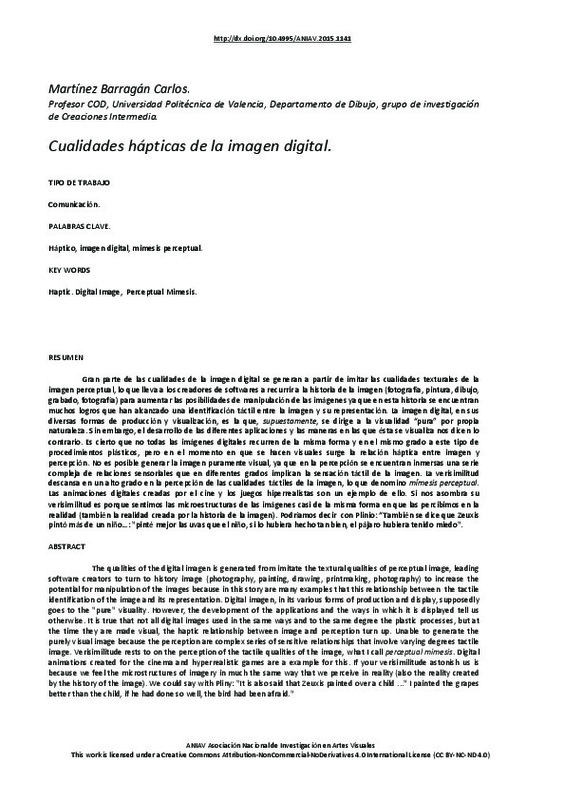|
Resumen:
|
[EN] The qualities of the digital imagen is generated from imitate the textural qualities of perceptual image, leading software creators to turn to history image (photography, painting, drawing, printmaking, photography) ...[+]
[EN] The qualities of the digital imagen is generated from imitate the textural qualities of perceptual image, leading software creators to turn to history image (photography, painting, drawing, printmaking, photography) to increase the potential for manipulation of the images because in this story are many examples that this relationship between the tactile identification of the image and its representation. Digital imagen, in its various forms of production and display, supposedly goes to the "pure" visuality. However, the development of the applications and the ways in which it is displayed tell us otherwise. It is true that not all digital images used in the same ways and to the same degree the plastic processes, but at the time they are made visual, the haptic relationship between image and perception turn up. Unable to generate the purely visual image because the perception are complex series of sensitive relationships that involve varying degrees tactile image. Verisimilitude rests to on the perception of the tactile qualities of the image, what I call perceptual mimesis. Digital animations created for the cinema and hyperrealistic games are a example for this. If your verisimilitude astonish us is because we feel the microstructures of imagery in much the same way that we perceive in reality (also the reality created by the history of the image). We could say with Pliny: "It is also said that Zeuxis painted over a child ..." I painted the grapes better than the child, if he had done so well, the bird had been afraid."
[-]
[ES] Gran parte de las cualidades de la imagen digital se generan a partir de imitar las cualidades texturales de la imagen perceptual, lo que lleva a los creadores de softwares a recurrir a la historia de la imagen ...[+]
[ES] Gran parte de las cualidades de la imagen digital se generan a partir de imitar las cualidades texturales de la imagen perceptual, lo que lleva a los creadores de softwares a recurrir a la historia de la imagen (fotografía, pintura, dibujo, grabado, fotografía) para crear las posibilidades de manipulación de las imágenes ya que en esta historia se encuentran muchos logros que han alcanzado una identificación táctil entre la imagen y su representación. La imagen digital, en sus diversas formas de producción y visualización, es la que, supuestamente, se dirige a la visualidad “pura” por propia naturaleza. Sin embargo, el desarrollo de las diferentes aplicaciones y las maneras en las que ésta se visualiza nos dicen lo contrario. Es cierto que no todas las imágenes digitales recurren de la misma forma y en el mismo grado a este tipo de procedimientos plásticos, pero en el momento en que se hacen visuales surge la relación háptica entre imagen y percepción. No es posible generar la imagen puramente visual, ya que en la percepción se encuentran inmersas una serie compleja de relaciones sensoriales que en diferentes grados implican la sensación táctil de la imagen. La verisimilitud descansa en un alto grado en la percepción de las cualidades táctiles de la imagen. Las animaciones digitales creadas por el cine y los juegos hiperrealistas son un ejemplo de ello. Si nos asombra su verisimilitud es porque sentimos las microestructuras de las formas casi de la misma forma en que las percibimos en la realidad (también de la realidad creada por la historia de la imagen). Podríamos decir con Plinio: “También se dice que Zeuxis pintó más de un niño…: "pinté mejor las uvas que el niño, si lo hubiera hecho tan bien, el pájaro hubiera tenido miedo".
[-]
|









